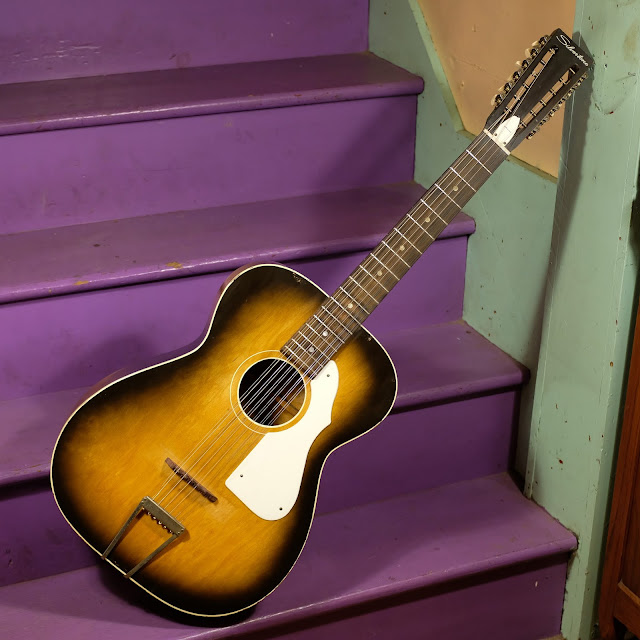1967 Harmony-made Silvertone 1225 (H912) 12-String 000-Size Guitar
Several years ago, this guitar was brought in with a few other 12-strings for consignment... or trade... or repair. It sat and sat and sat (beat-up birch Harmony 12-strings are not something one usually prioritizes) until the owner dropped-by with another project to fix over summer last year. Between that fix and some other work, this wound-up with me via trade. It then sat and sat and sat until I had a little bit of time on Wednesday to start glueing-up loose seams.
This model is mostly seen under the Stella brandname from the '60s where it's known as a Harmony H912. These are popular with blues players aping Leadbelly and other players who made their mark using big-bodied Oscar Schmidt-made Stellas in the '20s and '30s. The tailpiece-style load of these Harmony models (both this downmarket birch version and the fancy-pants Sovereign model have tailpieces and floating bridges) along with their ladder-bracing make them ideal for "stealing" that sound. It's brash, raucous, and chunkily-wonderful -- and you simply don't get that with modern-style 12s.
This model is mostly seen under the Stella brandname from the '60s where it's known as a Harmony H912. These are popular with blues players aping Leadbelly and other players who made their mark using big-bodied Oscar Schmidt-made Stellas in the '20s and '30s. The tailpiece-style load of these Harmony models (both this downmarket birch version and the fancy-pants Sovereign model have tailpieces and floating bridges) along with their ladder-bracing make them ideal for "stealing" that sound. It's brash, raucous, and chunkily-wonderful -- and you simply don't get that with modern-style 12s.
I'd initially thought that I might convert this box into some sort of mohan veena using 6 "slide" strings and 6 drones, but by the time I got the neck reset my "poor-old-guitar" sympathy kicked-in and I finished it off as-normal. Despite some old distortion/caving around the soundhole from too much time with loose bracing, it's shaped-up a nice, country-blues, crosspicking gem -- with a frontal, midsy, planky, aggressive sort of tone. In the lap it feels a lot larger than it is because of the wide neck and massive headstock, too.
Work included: a neck reset, fret level/dress, new fully-compensated rosewood floating bridge, replacement tailpiece, seam repairs, one replacement upper-bout brace, general cleaning, and a good setup. The neck is straight, the truss rod works, the fret height is still quite good, and it plays with bang-on 3/32" EA and 1/16" DGBE action at the 12th fret. I have a custom light set of strings on it gauged 22w/46w, 14/36w, 10/26w, 8/20w, 13/13, 9/9. This makes standard tuning chordal play slick, easy, and non-frustrating. You need to use a thinner, floppier pick to make them shine, though. I can easily see stringing this pretty heavy (54w-12 plus the octaves) and tuning down to C, though, for that Leadbelly effect.
Scale length: 25 1/8"
Nut width: 2"
String spacing at nut: 1 13/16"
String spacing at saddle: 2 7/16"
Nut width: 2"
String spacing at nut: 1 13/16"
String spacing at saddle: 2 7/16"
Body length: 19 1/4"
Lower bout width: 15 1/8"
Upper bout width: 11 5/8"
Lower bout width: 15 1/8"
Upper bout width: 11 5/8"
Side depth at endpin: 3 7/8"
Top wood: solid birch
Back/sides wood: solid birch
Neck wood: poplar
Fretboard: ebonized maple
Back/sides wood: solid birch
Neck wood: poplar
Fretboard: ebonized maple
Neck shape: 14-16" radius board w/mild-medium D-shaped rear
Bridge: new rosewood, fully compensated
Nut: original plastic
Condition notes: there are no cracks, but there's usewear/storage-wear here and there throughout. The truss rod cover is chipped (as 1/2 of these old Harmony covers are). The endpin is a replacement, the bridge is a replacement, the tailpiece is a replacement, and the two pearl dots in the fretboard extension are non-original. The rest of the guitar is all-original, however. There are also signs of old, not-quite-perfect repairwork, too -- including one back brace that was reglued but sprung-up and is stuck half-sprung (it's not an issue), the aforementioned distortion of the top around the soundhole, and the fact that the neck has reinforcement bolts installed through the neckblock and into the heel. When I reset the neck I both shimmed-up the joint and glued it as well as using the bolts that came with it. It's sturdy, now.
The fretboard extension dips down over the top a fair bit -- but not nearly so bad as when it arrived here!
My new bridge is fully-compensated so this plays nice and pain-free intonation-wise up and down the neck.
The tailpiece is off of an earlier, 1940s-era Harmony guitar, as I recall.
The website SilvertoneWorld is invaluable in figuring-out when some of these funky guitars were made. Apparently, this model was released in 1967 and it was only called the 1225 for that year -- so this has to be a '67 or late '66 build.
This tailpiece style has two sets of string-mounting-holes and one string is supposedly meant to go through both before going to the bridge. In this case, I've used the rear hole for the octave strings and the front hole for the normal strings. This works well-enough but does mean they're at slightly different back-angles as they approach the saddle. It might make more sense just to slightly enlarge one set of holes and double-string them...!
Here's the top distortion around the soundhole. It's not pretty but it's also not as bad as the picture makes it look. At any rate, there's a new, giant structural brace under the fretboard extension. The original ladder brace that was in that area was completely unattached -- hence why the top did this over time. It's stable now, though.





















Comments